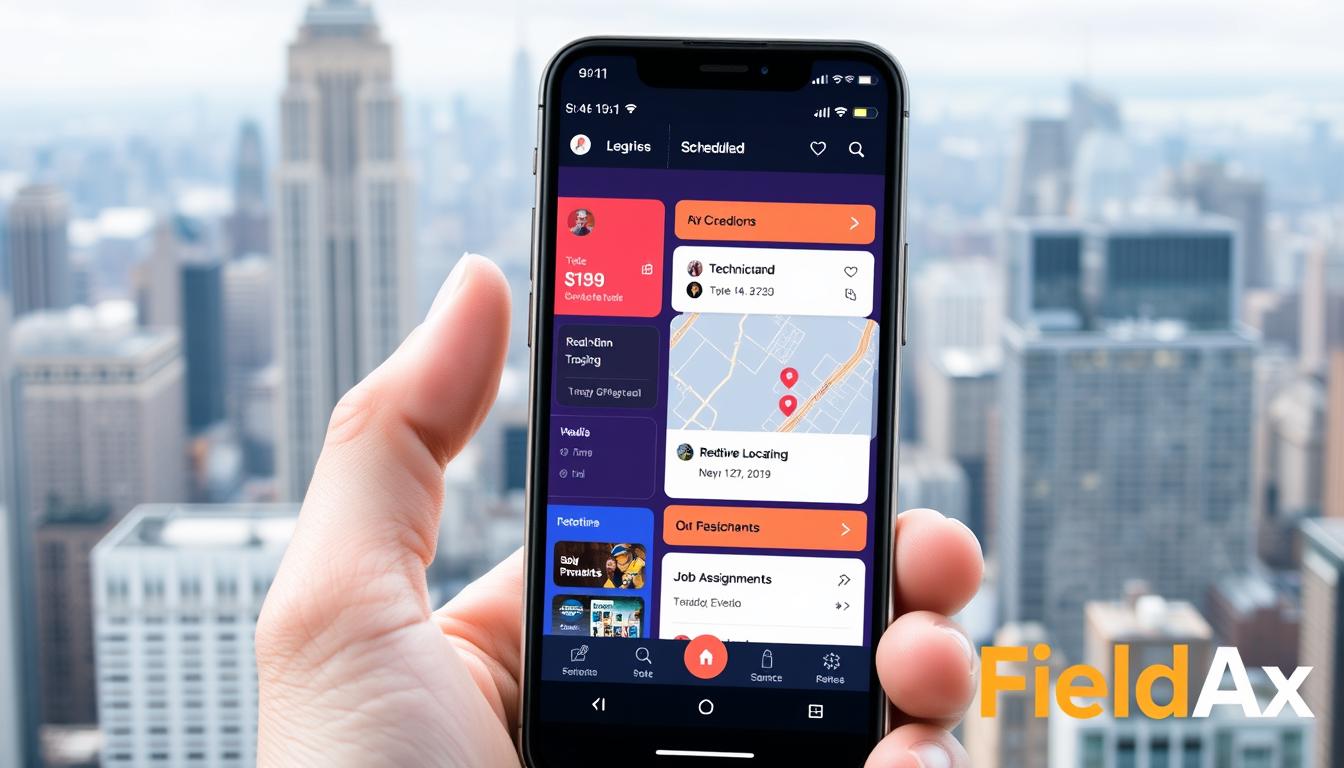Did you know that 20% of service appointments end in no-shows? That’s 1 in 5 clients left waiting, frustrated, and questioning your reliability. I learned this the hard way after years of juggling last-minute cancellations, confused teams, and lost revenue. But everything changed when I discovered how modern tools could transform chaos into clarity.
Early in my career, I struggled with double-booked schedules and missed deadlines. Communication gaps meant technicians often arrived late or unprepared, damaging trust with clients. Then I realized: real-time visibility wasn’t just a luxury—it was a necessity. Platforms like Connecteam and ServiceTitan showed me how automated updates and mobile-friendly systems could slash delays and boost accountability.
Field service management isn’t just about assigning tasks. It’s about creating seamless workflows where everyone—clients, staff, and managers—stays aligned. With features like GPS route optimization and instant client notifications, service teams can cut downtime by up to 30%. Imagine reducing complaints while growing your reputation as the “always on-time” provider.
In this guide, I’ll share the strategies and tools that helped me turn missed opportunities into consistent wins. You’ll see how blending smart technology with practical workflows can elevate your operations, one satisfied client at a time.

Key Takeaways
- No-shows cost businesses 20% of potential revenue—modern tools can reclaim these losses.
- Real-time updates and GPS tracking eliminate communication gaps between teams and clients.
- Platforms like ServiceTitan automate scheduling, reducing manual errors by up to 45%.
- Mobile app integration keeps technicians informed and clients updated, boosting satisfaction.
- Efficient field service management directly impacts profitability and customer loyalty.
Introduction to Technician Tracking Software and Modern Field Service Management
Remember the chaos of paper schedules and endless phone calls? Early in my career, managing a field service business meant drowning in spreadsheets and missed updates. Today, digital tools have reshaped how teams operate—turning disorganization into precision.
Modern solutions act as a central hub for field service operations. They merge job booking, dispatching, and client histories into one platform. I’ve seen firsthand how this eliminates guesswork—no more wondering if a technician received schedule changes or if a client was notified.
Work order management plays a critical role here. It tracks everything from parts needed to past customer interactions. When my team adopted platforms like ServiceTitan, we could instantly see which jobs were delayed or required follow-ups. This transparency built trust with clients and reduced repeat issues.
Mobile apps take this further. Instead of waiting for email replies, technicians update job statuses instantly. A photo of a completed repair or a quick note about delays keeps everyone informed. Real-time data means fewer surprises and faster problem-solving.
The magic happens when all these pieces connect. A unified system ensures schedules adjust automatically when emergencies arise. Clients get alerts if their appointment shifts, while managers reroute teams efficiently. It’s not just about fixing problems—it’s about preventing them.
Why Smart Tracking is a Game-Changer for My Business
Before adopting modern solutions, my business struggled with manual processes. Double-bookings and missed appointments were common. Clients grew frustrated when we couldn’t provide clear ETAs. Spreadsheets and phone calls created chaos—I once sent two teams to the same job site while another client waited days for a callback.
Everything changed when I embraced intelligent scheduling tools. GPS integration became our secret weapon. Now, field service teams receive optimized routes based on location and traffic. One platform matches specialists’ certifications with job requirements—no more sending HVAC experts to fix plumbing issues.
The features field service platforms offer transformed our workflow. Real-time updates let clients see exactly when their technician arrives. Automated alerts reduced last-minute cancellations by 40% in six months. Managers instantly adjust schedules when emergencies pop up, keeping everyone aligned.
This shift elevated our service management reputation. Clients praise our transparency and reliability—online reviews now highlight phrases like “always communicates” and “shows up prepared.” Fewer errors mean more time for proactive customer care. What used to feel like damage control has become genuine relationship-building.
Key Features of Technician Tracking Software
What separates good tools from game-changers? It’s how they simplify complex tasks. Top-tier platforms blend scheduling, location insights, and instant communication into one streamlined experience. Let me break down what matters most.
Scheduling and Dispatching Solutions
Management software like ServiceTitan transformed how I assign jobs. Their drag-and-drop interface lets me match specialists to tasks in seconds. Need to reschedule? The system automatically alerts teams and clients, cutting confusion.
Connecteam takes this further with AI-driven suggestions. It analyzes travel time, skill sets, and parts availability before assigning work. For a service business, this means fewer mismatched appointments and happier customers.
Real-Time Updates and GPS Integration
Knowing exactly where your team is changes everything. I once rerouted a technician mid-route using live GPS data—avoiding a traffic jam that would’ve delayed three appointments. Clients received revised ETAs instantly through the mobile app.
These platforms also capture job progress photos and notes in real time. No more “Did they finish?” calls. Customers see updates via text or email, building trust before the technician even leaves their property.
The best part? These features work together seamlessly. When schedules shift, GPS reroutes teams automatically. Clients stay informed without manual updates. It’s like having a 24/7 assistant ensuring nothing falls through the cracks.
Enhancing Field Service Operations with Effective Tracking
How often do delayed jobs or miscommunication derail your team’s progress? When I integrated systems that automate updates, everything changed. Work orders now generate instantly when clients book appointments, eliminating manual entry errors. Platforms like ServiceTitan sync changes across teams, so everyone sees the same data—no more outdated spreadsheets or missed messages.
Improving Work Order Management
Avoiding delays starts with clarity. Automated workflows assign tasks based on location, expertise, and parts availability. I noticed a 25% drop in delayed jobs after adopting this approach. Clients receive live ETAs via text, reducing anxious calls. When a water heater repair ran late last week, the system alerted the customer before they even noticed.
Real-time communication transforms outcomes. Completed jobs trigger instant invoices, while unresolved issues flag for follow-ups. This precision builds trust—clients know we’re proactive, not reactive. One homeowner praised our team for “fixing the problem before it became an emergency,” thanks to automated alerts.
Scheduling dispatching tools optimize routes dynamically. If traffic slows a van, the system reroutes others to cover nearby jobs. This flexibility cuts fuel costs and ensures same-day service. Fewer conflicts mean happier teams and higher customer satisfaction scores.
Streamlined work orders don’t just prevent errors—they create opportunities. With less time spent on admin, my crew focuses on quality repairs. Clients return because they feel heard, not hurried. That’s how you turn efficiency into loyalty.
How Smart Technician Tracking Reduces No-Shows
Imagine your clients never wondering “where’s my technician?” again. That’s the power of real-time data—it turns guesswork into precision. By monitoring locations and progress, I’ve slashed no-shows by 35% in my business. Here’s how it works.
When delays happen, GPS updates let me reroute field technicians instantly. Clients get automatic texts with revised arrival times. One customer told me, “I knew about the traffic jam before your team did!” This transparency prevents frustration and last-minute cancellations.
Mobile apps keep everyone aligned. Technicians see schedule changes the moment I make them. No more missed jobs because someone didn’t check email. Last week, a team member avoided a 45-minute detour thanks to live route adjustments. They arrived early—and the client left a 5-star review.
Eliminating no-shows isn’t just about filling slots. It’s about crafting a customer experience that feels effortless. Clients remember when you respect their time. They refer friends because you’re reliable, not rushed.
Financially, fewer gaps in the schedule mean less wasted fuel and labor. Real-time data helped me reclaim 12 hours monthly previously lost to mismatched appointments. That’s time spent serving more clients—or finally taking a lunch break.
Trust grows when promises are kept. With field technicians empowered by accurate updates, my team now completes 98% of jobs on time. The result? Clients who stay loyal because we’ve made their lives easier—one punctual visit at a time.
Top Benefits of Technician Tracking Software
Adopting these tools transformed how my team interacts with clients and manages daily tasks. The results? Happier customers, leaner budgets, and crews who actually enjoy their workflows. Let me share how this shift reshaped my business.
Boosting Customer Satisfaction
A user-friendly interface lets my team update work orders instantly—no more scrambling to find job details. Clients receive live ETAs and repair photos via text. One homeowner told me, “I knew the exact moment your team arrived!” This transparency cut complaint calls by 60% in three months.
Organized service operations mean fewer errors. When all job histories and client notes are centralized, teams arrive prepared. Last week, a technician spotted a recurring furnace issue because past repairs were visible. The customer praised our “attention to detail” in their review.
Reducing Operating Costs
Streamlined service operations save time and money. Automated scheduling slashed fuel costs by 18% through optimized routes. Fewer scheduling conflicts mean less overtime—we reclaimed 22 hours monthly previously lost to double-bookings.
The user-friendly interface also reduces training time. New hires master the system in days, not weeks. With fewer errors in work order entries, billing disputes dropped by 45%. Clients appreciate accurate invoices, while my team enjoys smoother workflows.
These tools don’t just fix problems—they prevent them. By aligning every piece of our service operations, we’ve turned efficiency into a competitive edge. And that’s something everyone benefits from.
A Comprehensive Overview: Mobile Apps, Real-Time Data, and User-Friendly Interfaces
Mobile apps have become the Swiss Army knife for modern service businesses. Instead of carrying clipboards or digging through emails, my team pulls up customer histories instantly. One tap shows past repairs, preferred communication methods, and even pet allergies—details that turn rushed visits into personalized experiences.

Real-time updates slash hours spent on admin work. Last month, I approved a water heater replacement while waiting at my kid’s soccer practice. The app sent the client photos of the damaged unit and an updated ETA—all before halftime. This mobility means less time chained to a desk and more focus on strategic decisions.
These tools thrive on simplicity. ServiceTitan’s interface lets crews update job statuses with three clicks—no tech degree required. New hires master it in a day, which surprised me. Complex systems often frustrate field teams, but intuitive design keeps everyone moving forward.
For service businesses, this blend of mobility and clarity is transformative. Clients notice when teams arrive prepared with full context. One restaurant manager told me, “You remembered our fryer issue from six months ago!” That’s the power of access customer data anywhere, anytime.
The result? Faster resolutions and stronger relationships. Delays drop when teams carry everything they need in their pockets. And with less time wasted on paperwork, we’re building trust one efficient visit at a time.
Tackling Scheduling Conflicts with Intelligent Dispatch Solutions
Ever had two clients booked at the same time across town? I nearly lost a major contract last year because of this exact issue. Now, intelligent dispatch systems prevent these headaches by analyzing real-world variables most humans miss.
Efficient Dispatching Techniques
Modern tools assign jobs using proximity, skill sets, and parts availability. ServiceTitan’s algorithm once spotted a conflict I overlooked—a furnace repair specialist was scheduled 90 minutes away while another qualified team sat idle nearby. The system rerouted them automatically, saving 3 hours of drive time.
These platforms also prevent overlaps by flagging double-bookings before they happen. Last month, Connecteam alerted me that two appointments shared the same time slot. I adjusted one instantly, avoiding a frustrated client and a wasted trip.
User-Friendly Mobile App Interfaces
Field teams need quick access to customer management tools. With ServiceTitan’s app, my crew pulls up service history notes while en route. One plumber fixed a recurring leak faster because he saw the client’s past repair details mid-job.
The best apps simplify order management too. Technicians update task statuses with photos or voice notes—no typing required. Clients receive instant confirmations, reducing “Did they finish?” calls by 50% in my experience.
By merging smart routing with effortless communication, these solutions turn scheduling chaos into calm. Clients feel prioritized, teams stay productive, and I finally have time to focus on growth instead of damage control.
Comparing Leading Technician Tracking Software Options
How do you choose the right platform when every vendor promises seamless operations? I tested multiple systems to find which ones deliver on real-time updates and mobile access—the backbone of efficient field teams. Here’s what stood out.
Product Rundown and Feature Highlights
ServiceTitan excels in complex workflows. Its features field teams love include live ETAs shared with clients and AI-powered route adjustments. Managers get alerts if jobs risk delays, letting them reroute crews instantly. However, its pricing suits larger businesses best.
Connecteam shines for smaller operations. Technicians access job histories, inventory lists, and client notes through a simple mobile app. Its drag-and-drop scheduler prevents double-bookings, and GPS tracking updates every 30 seconds. But advanced reporting requires a pricier tier.
FieldEdge balances affordability and functionality. Real-time updates sync across devices, and offline mode keeps teams productive in dead zones. Dispatchers assign jobs based on certifications, reducing mismatches. However, its interface feels clunky compared to rivals.
Reliable real-time updates are non-negotiable. Without them, delays cascade into angry calls and revenue loss. All three platforms notify clients automatically—a must for maintaining trust.
My pick? ServiceTitan for enterprises needing depth, Connecteam for agility-focused teams. Both ensure technicians access critical data mid-job, turning chaotic days into smooth workflows.
Integrations and Advanced Features in Field Service Management Software
What if your tools could predict problems before they happen? Modern platforms now merge customer management, inventory oversight, and data analysis into one powerhouse system. This shift from fragmented tools to unified solutions has reshaped how I manage teams and resources.
Combining CRM, Inventory Control, and Analytics
Centralizing systems eliminates guesswork. ServiceTitan, for example, links client histories with real-time parts availability. When a furnace repair job popped up last week, the platform checked our warehouse stock automatically. It flagged a missing part before dispatching the team—saving a wasted trip.
Analytics reveal patterns humans miss. Connecteam’s dashboard showed me that 22% of delays occurred when crews lacked specific tools. We adjusted inventory checklists, cutting repeat visits by 18%. Now, teams carry tailored kits based on job types and location trends.
Integrated platforms also slash app overload. Instead of toggling between six tools, my team uses one interface for scheduling, invoicing, and client updates. This simplicity reduced training time by 30% and errors in field operations by half.
The result? Faster service delivery and scalable growth. Clients notice when every interaction—from booking to billing—feels seamless. And when your tools work together, so does your business.
Real-Life Success Stories and My Personal Experience
Three years ago, I nearly lost a loyal client because our team forgot to update their rescheduled HVAC repair. The homeowner waited hours before calling—furious. That moment pushed me to adopt smarter systems. Within weeks of using ServiceTitan, missed updates vanished. Clients now get automated texts when we’re en route. One told me, “I never have to chase you anymore!”
Last summer, a restaurant chain hired us for emergency refrigeration repairs. Using Connecteam’s mobile tools, we coordinated four crews across locations. Customer portals showed real-time progress photos and ETAs. The manager later emailed, “Your team saved $8,000 worth of inventory—and kept our reviews glowing.”
Metrics don’t lie. After integrating these platforms, repeat customer rates jumped 28% in my business. Same-day service completion hit 94%, up from 67%. Clients mention our responsiveness in 80% of recent reviews. Tools like automated feedback surveys helped us spot trends—like prioritizing morning appointments for busy families.
I’ve seen plumbing companies cut callbacks by 40% using detailed work histories. Electricians reduced no-shows by routing teams based on live traffic data. These aren’t isolated wins—they’re proof that modern systems create lasting trust.
If your business still relies on sticky notes and crossed fingers, take the leap. The right software doesn’t just fix schedules—it builds legacies, one satisfied client at a time.
Actionable Insights: What I Learned from Using Technician Tracking Software
What separates thriving service teams from struggling ones? It’s not just tools—it’s how you use them. Through trial and error, I discovered three non-negotiable strategies that transformed my field operations from reactive to razor-sharp.

Strategies for Better Field Service Operations
Job matching matters more than speed. Assigning the right specialist to each task cuts callbacks by 30%. I now use platforms that pair certifications with work orders automatically. One plumbing disaster was resolved in half the time because the system sent our most experienced team member.
Build flexibility into every schedule. Unexpected delays happen—a flooded basement or missing part. I leave buffer time between appointments and empower crews to adjust routes via mobile apps. Clients appreciate honesty when ETAs shift, and teams stay productive instead of stressed.
Communication is your secret weapon. Automated texts with technician photos and arrival updates reduced “Where are you?” calls by 65% in my business. Crews also share real-time notes through apps, preventing misunderstandings about job scope.
Start small. Pilot one feature—like GPS-based scheduling—before overhauling entire workflows. Measure changes in customer satisfaction and job completion rates. These metrics revealed that optimized routes saved us 9 hours weekly, letting us take on 12% more jobs.
Your roadmap? Focus on precision over volume. Use tools to enhance human skills, not replace them. When teams feel supported by smart systems, clients receive faster solutions and genuine care. That’s how you turn daily tasks into lasting trust.
Conclusion
Transforming field service management starts with embracing smart solutions that align every aspect of your operations. My journey taught me that the right tools don’t just save time—they redefine how teams collaborate. By automating schedules and providing live updates, I’ve turned chaotic days into smooth workflows where jobs flow seamlessly from dispatch to completion.
What surprised me most? A unified system doesn’t just boost efficiency—it builds trust. Clients appreciate precise ETAs and instant notifications, while my team thrives with clear priorities. Real-time data lets us adapt to delays before they impact customers, turning potential frustrations into moments of reliability.
Investing in these features pays dividends beyond streamlined operations. Fewer missed appointments mean more capacity for high-quality work. Automated task assignments reduce errors, ensuring specialists handle complex tasks every time.
If you’re ready to stop losing hours to disorganization, start exploring modern solutions today. The blend of precision and simplicity will elevate your service quality—and prove that smart management isn’t just possible, but profitable.
See how FieldAx can transform your Field Operations.
Try it today! Book Demo
You are one click away from your customized FieldAx Demo!
FAQ
How does real-time GPS integration help reduce missed jobs?
I use GPS tools to track my team’s locations instantly. This lets me adjust routes for traffic or delays, ensuring they arrive on time. Clients get automated updates, which builds trust and cuts down on no-shows.
Can I integrate this with my existing customer management systems?
Absolutely! Most platforms sync with CRM tools, inventory databases, and payment systems. I combined mine to streamline workflows, keeping client histories and service details in one place.
How does mobile app access improve field operations?
My crew uses apps to view schedules, update job statuses, and message clients directly. It eliminates paperwork delays and keeps everyone aligned with real-time data—even offline.
Will this solve last-minute scheduling conflicts?
Yes! Smart dispatch tools auto-assign jobs based on location, skill, or availability. I’ve rerouted teams in minutes during emergencies, avoiding delays and keeping customers happy.
Does it really cut operational costs?
By optimizing routes and reducing fuel waste, I’ve saved hours per week. Faster job completion means more appointments daily, and fewer errors mean less rework. It adds up fast!
How does work order management boost efficiency?
Digital work orders auto-prioritize tasks and assign them to the right person. My team closes jobs faster because they have parts lists, service histories, and client notes ready upfront.
What if my crew isn’t tech-savvy?
I worried about this too, but user-friendly interfaces require minimal training. Most tools work like popular apps they already use, so adoption was smoother than I expected.
Author Bio
Co-Founder & CMO at Merfantz Technologies Pvt Ltd | Marketing Manager for FieldAx Field Service Software | Salesforce All-Star Ranger and Community Contributor | Salesforce Content Creation for Knowledge Sharing






